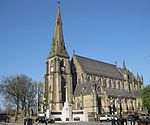Bury Market
Buildings and structures in Bury, Greater ManchesterGreater Manchester building and structure stubsRetail markets in EnglandTourist attractions in the Metropolitan Borough of Bury

Bury Market is an open-air market in the town of Bury, Greater Manchester, England. It consists of a large market hall, with extensive stalls outside, selling fruit, flowers, clothing, hardware and groceries. A new fish and meat market hall was constructed in the 1990s on the site of a former National Westminster Bank. The market opens on Wednesdays, Fridays and Saturdays, and attracts visitors from miles around. It is famed for its black pudding stalls and is near Bury's main shopping centre, Mill Gate. The open air market is only open on Wednesday, Friday and Saturday but the indoor market is open every day except Sunday.
Excerpt from the Wikipedia article Bury Market (License: CC BY-SA 3.0, Authors, Images).Bury Market
Murray Road,
Geographical coordinates (GPS) Address Nearby Places Show on map
Geographical coordinates (GPS)
| Latitude | Longitude |
|---|---|
| N 53.5912 ° | E -2.2945 ° |
Address
Bury Market
Murray Road
BL9 0BJ , Buckley Wells
England, United Kingdom
Open on Google Maps









